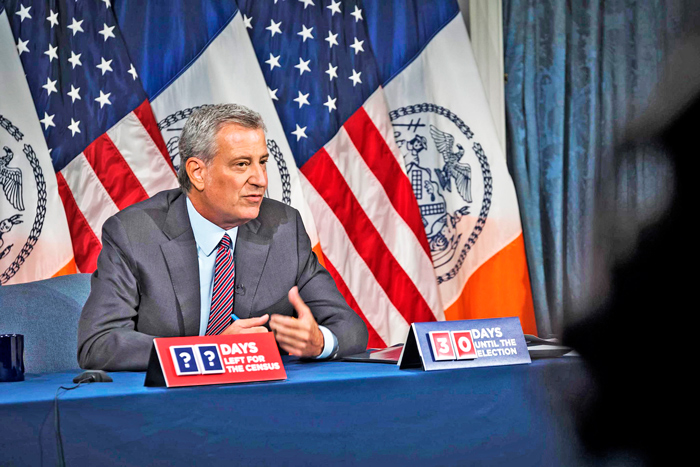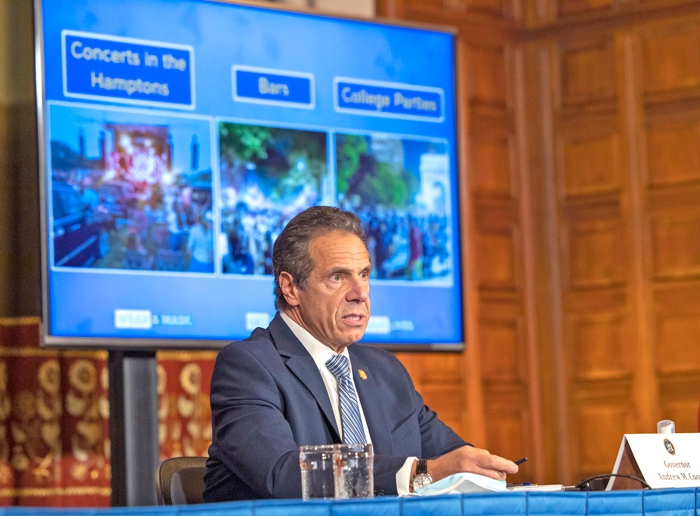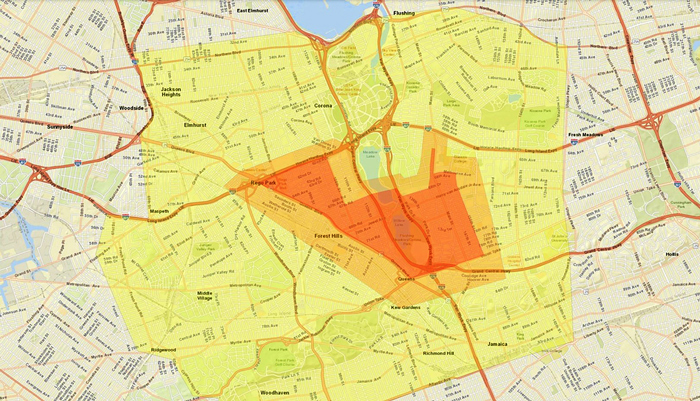Photo Courtesy of Mike Groll/Office of the Governor
“Our strategy is to crush the cluster and stop the spread, and we’re announcing a special initiative to do just that,” Gov. Cuomo said.
By Michael V. Cusenza
A new State cluster initiative will address COVID-19 hot spots that have cropped up in Queens, Brooklyn and Upstate counties Broome, Orange, and Rockland, Gov. Andrew Cuomo announced Tuesday.
Working with the top public health experts, the administration developed a science-based approach to attack these clusters and stop any further spread of the virus, including new rules and restrictions directly targeted to areas with the highest concentration of COVID cases and the surrounding communities. The new rules will be in effect for a minimum of 14 days, Cuomo noted.
According to the governor, the initiative is composed of three steps: Take dramatic action within the cluster; take action in the area surrounding the cluster to stop the spread; take precautionary action in the outlying communities.
The initiative will divide clusters and the areas around them into three categories with successively higher restrictions within each one:

Photo Courtesy of Ed Reed/Mayoral Photography Office
“Once again, it’s time for our city to dig deep and fight this virus the best way we know how: by wearing a mask, practicing social distancing, and looking after our seniors and most vulnerable neighbors,” Mayor de Blasio said.
Red Zone — Cluster Itself
- Houses of Worship: 25 percent capacity, 10 people maximum
- Mass Gatherings: Prohibited
- Businesses: Only essential businesses open
- Dining: Takeout only
- Schools: Closed, remote only
Orange Zone — Warning Zone
- Houses of Worship: 33 percent capacity, 25 people maximum
- Mass Gatherings: 10 people maximum, indoor and outdoor
- Businesses: Closing high-risk non-essential businesses, such as gyms and personal care
- Dining: Outdoor dining only, 4 person maximum per table
- Schools: Closed, remote only
Yellow Zone — Precautionary Zone
- Houses of Worship: 50 percent capacity
- Mass Gatherings: 25 people maximum, indoor and outdoor
- Businesses: Open
- Dining: Indoor and outdoor dining, four-person maximum per table
- Schools: Open with mandatory weekly testing of students and teachers/staff for in-person settings. The State Department of Health will establish a percentage of teachers and students/staff that need to be tested by Friday.
The enforcement of the zones will go into effect as soon as Wednesday, Oct. 7, and no later than Friday, Oct. 9. Cuomo also announced that fines for the sponsors of mass gatherings in violation of State public health rules will be increased to $15,000.
Jackson Heights, Elmhurst, Maspeth, Middle Village, Ridgewood, Woodhaven, Richmond Hill, Jamaica, Flushing, and Corona are in the Yellow Zone, according to the initiative; areas of concern include parts of Kew Gardens, Kew Gardens Hills, Forest Hills, Rego Park, and Far Rockaway have been designated Orange or Red zones.
“A cluster is just that—it’s a cluster of cases, a high density of cases, and it seeps and grows from that cluster almost in concentric circles. Drop a pebble into the pond, the pebble goes in, then there’s a ring, two rings, three rings, and the rings continue across the pond. When you see the cluster, you have to stop it at that point,” Cuomo said. “Our strategy is to crush the cluster and stop the spread, and we’re announcing a special initiative to do just that. Step One, you take the most dramatic action within the cluster itself where you have the highest density of cases. Understanding that the people in that cluster interface with the surrounding communities, take additional action in the communities surrounding the cluster. Then as a precautionary measure, take action in the communities that are outlying that area.”
Additionally this week, Mayor Bill de Blasio sent a proposal to the New York State government to close non-essential businesses, including public and private schools, in nine city ZIP codes where COVID-19 rates have remained over 3 percent for the past seven days. This plan, which would have begun on Wednesday, Oct. 7, also includes closing down high-risk activities in 11 additional city ZIP codes of concern.
While indoor and outdoor dining will be closed in these nine ZIP codes, restaurants will be allowed to continue serving customers for pickup and to-go meals. If successful, schools and non-essential businesses in the nine ZIP codes should be allowed to reopen after two weeks if rates are under 3 percent. If difficulties remain and cases continue to rise, all should remain closed for four weeks.
The borough communities on this dreaded list are Edgemere/Far Rockaway (5.63 percent 14-day positivity as of Oct. 4); Kew Gardens (3.81 percent); and Kew Gardens Hills/Pomonok (3.86 percent).
The proposal also includes actions in ZIP codes where rates have remained between two and three percent. In these neighborhoods, high-risk activities—like indoor dining, gyms, and indoor and outdoor pools—had been scheduled to be closed starting on Wednesday, Oct. 7. These Queens areas include: Rego Park, Fresh Meadows/Hillcrest, Jamaica Estates/Jamaica Hills, Auburndale/Fresh Meadows/Pomonok/Utopia.
“New Yorkers have worked hard to fight back COVID-19, and we don’t make this recommendation lightly. But science guides our decision-making in this city—and we go where the facts take us,” de Blasio said. “Once again, it’s time for our city to dig deep and fight this virus the best way we know how: by wearing a mask, practicing social distancing, and looking after our seniors and most vulnerable neighbors.”


